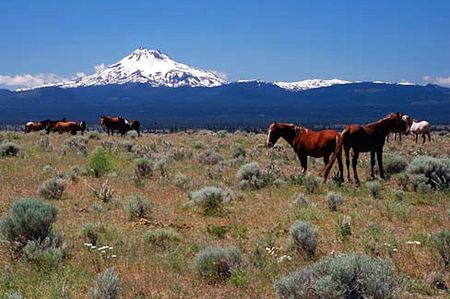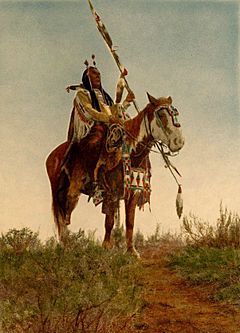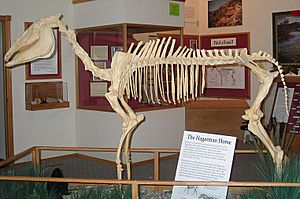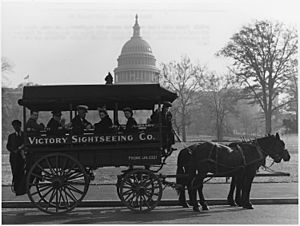Horses in the United States facts for kids
Horses have always been super important in American life and culture, right from the start. In 2008, there were about 9.2 million horses in the U.S. Also, 4.6 million people worked in jobs connected to horses. Interestingly, around 82,000 wild horses, called feral horses, still roam free, mostly in the Western United States.
Even though horses first evolved in North America, they disappeared from the continent about 8,000 to 12,000 years ago. But in 1493, Christopher Columbus brought Spanish horses back to the Americas. They first arrived in the Virgin Islands. Later, Hernán Cortés brought them to the mainland in 1519.
From Mexico and Florida, horses moved north. British, French, and other European settlers also brought horses to the east and west coasts. Native peoples quickly learned to use horses. They developed their own special horse culture, different from the Europeans.
Horses were a big part of American life until the 1900s. That's when machines became common. Horses were used less for work, travel, and business. Today, most horses in the U.S. are used for fun and sports. But some still do special jobs.
Contents
How Horses Evolved in North America
The very first direct ancestor of modern horses was called Eohippus. Its fossils have been found in North America, especially in Wyoming. Later, fossils of the Hagerman horse were found in Idaho. These fossils are about 3.5 million years old.
Scientists believe these are the oldest remains of the Equus family. This family includes all living horses, donkeys, and zebras. Equus horses were common in North America. They spread to other parts of the world about 2.5 million years ago.

Studies show that all North American fossils of horse-like animals, including domestic horses and Przewalski's horse, belong to the same species: E. ferus. Other horse fossils found in North America belong to a different species called Haringtonhippus francisci.
Evidence from Canada shows horses lived in North America as recently as 12,000 years ago. Other studies suggest they were here until 8,000 to 10,000 years ago.
Horses Disappear and Return
Horses in North America eventually died out. This happened along with many other large animals during the Ice Age, between 15,000 and 10,000 years ago. Scientists aren't sure why this happened. Since these animals had been doing well for millions of years, something unusual must have occurred.
One idea is that climate change caused it. For example, in Alaska, the grassy plains changed to shrubby areas with plants horses didn't like. Another idea is that humans who arrived in North America hunted too many horses. This extinction happened around the same time the Clovis culture (early big-game hunters) appeared.
Thousands of years later, horses returned to the Americas. This was long after people had learned to tame horses. Christopher Columbus brought the first ones in 1493. These were Iberian horses. They first came to Hispaniola, then to other parts of South and Central America.
In 1519, Hernán Cortés brought 16 horses to the mainland. Later explorers like Coronado and De Soto brought even more. Some came from Spain, others from Spanish horse farms in the Caribbean.
These tame horses were the ancestors of what we now call Colonial Spanish Horses. They were common in the southeastern and western U.S. until about 1850. Then, people started breeding them with larger horses. This changed their look and mixed their Spanish genes.
Some horses got lost or stolen and formed large herds of feral horses, known as mustangs. Today, some domestic horses still look like the original Colonial Spanish type. These include the Spanish Mustang, Choctaw horse, Florida Cracker horse, and the Marsh Tacky.
Horses in American History

European settlers brought many different kinds of horses to the Americas. The first ones were smaller because they had to fit on ships. In the mid-1800s, larger draft horses (workhorses) started arriving. By the 1880s, thousands had come. Formal horse racing in the United States began in 1665 in New York.
Native American people got horses from the Spanish in different ways. It probably took time for them to learn to ride and manage horses. It's thought that Native peoples didn't get enough horses to become a "horse culture" until around 1630–1650. Horses slowly spread north from a trade center in Santa Fe, New Mexico.
The Comanche people were among the first tribes to get and use horses well. By 1742, explorers reported that the Crow and Blackfoot people also had horses. Horses became a huge part of Native American life, especially for the Plains Indians. They saw horses as a sign of wealth and used them for hunting, travel, and fighting.
In the 1800s, horses did many jobs. In the West, cowboys rode them to manage cattle on big ranches and during cattle drives. In cities, horses pulled carriages and public transport. They also hauled goods and worked on farms. Sometimes, horses were even more efficient than steam engines for certain tasks.
Sadly, horses in cities like New York (where over 130,000 horses were used) were often treated badly. This led to the creation of the first ASPCA (American Society for the Prevention of Cruelty to Animals) in 1866. Also in the 1800s, the Standardbred horse breed developed in the U.S. for harness racing, and many thoroughbred horse races were started.
At the start of the 1900s, the United States Department of Agriculture set up farms to research and preserve American horse breeds. They also developed horses for the military and farming. But after World War I, more machines were used for transport. This caused horse numbers to drop. A 1926 report said horse prices were the lowest in 60 years. However, horse numbers went up again in the 1960s as people started using them for fun.
Horse Population Today
In 1912, the United States and Russia had the most horses in the world. The U.S. was second. In March 1915, there were about 20 million horses in the United States. But as machines took over many jobs, the number of horses used as working animals went down. By 1959, there were only 4.5 million horses.
Numbers started to rise again. By 1968, there were about 7 million horses, mostly used for riding. In 2005, there were around 9 million horses.
In 2013, the Bureau of Land Management (BLM) estimated about 82,000 wild horses lived on federal lands in the western U.S. The BLM looks after these horses. Other wild horse groups live in the U.S., especially on islands off the Atlantic coast. The National Park Service oversees these groups.
For example, there are Banker horses in North Carolina, Cumberland Island horses in Georgia, and horses on the Maryland side of Assateague Island, home to the Chincoteague pony. In Canada, there's a similar group called the Sable Island horse in Nova Scotia.




